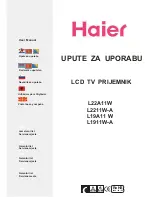
CL4790 User Guide
Version 2.0
Americas: +1-800-492-2320 Option 2
Europe: +44-1628-858-940
Hong Kong: +852-2923-0610
www.lairdtech.com/ramp
6
CONN-GUIDE_CL4790
T
HEORY OF
O
PERATION
RF Architecture
As opposed to a Server/Client protocol, a Masterless protocol does not require devices to be within range of a
central synchronizing device (Server) to communicate. The communicating devices only need to be within
range of each other. Communication between devices that are out of range of each other is also possible
using repeaters or Host systems that can direct the data through a Daisy Chain type topology.
Network Topologies
Topology refers to the shape of a network, or the network's layout. The way different nodes in a network
connect to each other and how they communicate is determined by the network's topology. The CL4790s
have a Masterless communication protocol, referred to as Peer-to-Peer, which can be used to implement both
Point-to-Point and Point-to-Multipoint topologies.
See the
AC4790 Embedded Module User Manual
for more
detailed information about setting up different topologies using the advanced API features in the 4790 family
of radios.
Modes of Operation
The CL4790 has three different operating modes:
If the transceiver is not communicating with another radio, it is in Receive mode actively listening for a sync
pulse from another transceiver. If the transceiver determines that it hears a sync pulse that is addressed to
itself or broadcast on its network, it responds by going into session with the radio that sent the pulse. The
LINK LED on the CL4790 illuminates to show that it is In Session. A transceiver enters Transmit or Command
mode when the OEM host sends data over the serial interface. The contents of the data on the serial
interface determine which of two modes the radio enters.
Transmit Mode
All packets sent over the RF are either Addressed or Broadcast packets. You may dynamically control
Broadcast and Addressed delivery with the API Control byte, which can be modified during operation with
On-the-Fly commands (for more information on APIs and on-the-fly commands, see the AC4790 Embedded
Module User Manual. To prohibit transceivers from receiving broadcast packets, Unicast only can be enabled.
When a radio has data to transmit, it sends out a sync pulse to initiate a session with one or more radios. This
25 ms sync pulse is sent during the first half of each 50 ms hop and transparent to the OEM Host. Once a
Session has been established, the radio transmits the data during the remaining 25 ms of the current hop.
The radio will stay in transmit mode until its Session Count expires. When sending addressed packets, Session
Count is defined as Session Count Refresh (EEPROM address 0xC4) + number of transmit retries (EEPROM
address 0x4C). When sending broadcast packets, Session Count is equal to Session Count Refresh (EEPROM
address 0xC4) + number of broadcast attempts (EEPROM address 0x4D). Once the radio exits the Session it
returns to the default Receive Mode.
Addressed Packets
When sending an addressed packet, the RF packet sends only to the receiver specified
in the Destination Address. To increase the odds of successful delivery, Transmit Retries
are utilized. Transparent to the OEM host, the sending radio sends the RF packet to the
intended receiver. If the receiver receives the packet free of errors, it returns an RF
acknowledge within the same 50 ms hop. If a receive acknowledgement is not
received, the radio uses a transmit retry to resend the packet. The radio continues
































